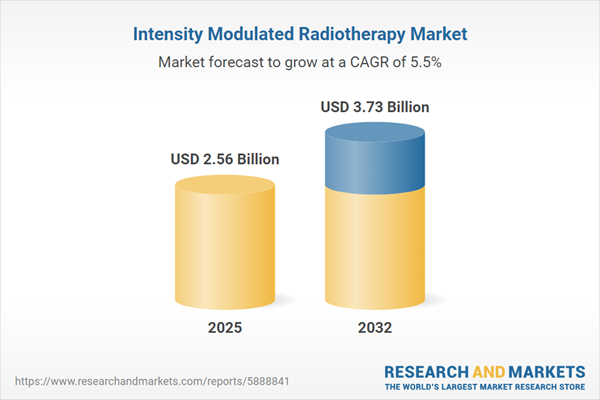Speak directly to the analyst to clarify any post sales queries you may have.
The intensity modulated radiotherapy market is advancing rapidly as oncology centers worldwide seek more precise and customizable cancer treatments. Key technological progress, shifting regulatory landscapes, and evolving operational demands are reshaping how providers adopt and utilize radiotherapy innovations across diverse clinical environments.
Market Snapshot: Intensity Modulated Radiotherapy Market Overview
The intensity modulated radiotherapy market grew from USD 2.43 billion in 2024 to USD 2.56 billion in 2025. It is expected to continue growing at a CAGR of 5.53%, reaching USD 3.73 billion by 2032. These figures highlight sustained interest from stakeholders across the healthcare spectrum for advanced radiotherapy technologies, driven by expanding clinical applications and increased infrastructure investments.
Scope & Segmentation
- Component: Equipment (including Imaging Systems, Linear Accelerators—Conventional, High Energy, Low Energy, and Multileaf Collimators), Services (Consulting, Maintenance, Training), and Software (Delivery System, Planning System).
- Technique: Sliding Window, Step and Shoot, Volumetric Modulated Arc (Multi Arc, Single Arc).
- Application: Brain Tumor, Breast Cancer, Gynecological Cancer, Head and Neck Cancer, Prostate Cancer.
- End User: Ambulatory Surgical Centers, Cancer Treatment Centers, Hospitals, Research Institutes.
- Patient Type: Adult, Pediatric.
- Region: Americas (North America—United States, Canada, Mexico; Latin America—Brazil, Argentina, Chile, Colombia, Peru), Europe, Middle East & Africa (Europe—United Kingdom, Germany, France, Russia, Italy, Spain, Netherlands, Sweden, Poland, Switzerland; Middle East—United Arab Emirates, Saudi Arabia, Qatar, Turkey, Israel; Africa—South Africa, Nigeria, Egypt, Kenya), Asia-Pacific (China, India, Japan, Australia, South Korea, Indonesia, Thailand, Malaysia, Singapore, Taiwan).
- Leading Companies: Varian Medical Systems, Elekta AB, Accuray Incorporated, Ion Beam Applications, ViewRay Inc., Mevion Medical Systems, Brainlab AG, Hitachi, Toshiba Corporation, Shinva Medical Instrument.
Key Takeaways for Decision Makers
- Precision and workflow automation, such as adaptive planning and AI-enabled contouring, are now essential for efficient, personalized oncology treatments.
- The integration of modular hardware and cloud-based software facilitates scalable upgrades, supporting facilities in responding to both clinical needs and external pressures.
- Multidisciplinary collaboration between engineers, oncologists, and physicists accelerates innovation, delivering new planning algorithms and real-time imaging capabilities.
- Service, maintenance, and training are playing an increasingly critical role, as institutions focus on operational excellence and regulatory compliance.
- Regional growth dynamics reveal that tailored strategies are necessary to address differing adoption rates, with advanced markets prioritizing next-generation therapies and emerging markets expanding foundational infrastructure.
Tariff Impact on the IMRT Supply Chain
Recent United States import tariffs have elevated costs for core radiotherapy components. This has prompted suppliers and healthcare providers to adapt sourcing strategies, optimize modular system investments, and embrace predictive maintenance solutions. Service providers are responding with remote diagnostics and training, while software developers accelerate the development of platform-agnostic tools to enhance supply chain flexibility. These market adjustments highlight the need for resilient operational strategies that safeguard continuity and cost management.
Methodology & Data Sources
This research applies a dual approach, combining expert interviews, stakeholder surveys, and industry workshops with comprehensive secondary analysis of peer-reviewed literature, regulatory filings, and patent data. An integrated analytical framework, with panel validation and triangulation, ensures that market trends and strategic recommendations are precise, actionable, and rooted in validated insights.
Why This Report Matters
- Provides senior leaders with a comprehensive view of evolving radiotherapy trends and practical market entry options.
- Supports strategic planning through clear segmentation, regional dynamics, and competitive intelligence not readily available elsewhere.
- Informs investment and partnership priorities with actionable insights into technology adoption, service innovations, and workflow transformations.
Conclusion
Stakeholders who align technology, operations, and partnerships will be best positioned to capitalize on the evolving intensity modulated radiotherapy market. Informed decision-making, grounded in up-to-date intelligence, will enable sustained clinical and commercial success as the field advances.
Additional Product Information:
- Purchase of this report includes 1 year online access with quarterly updates.
- This report can be updated on request. Please contact our Customer Experience team using the Ask a Question widget on our website.
Table of Contents
3. Executive Summary
4. Market Overview
7. Cumulative Impact of Artificial Intelligence 2025
Companies Mentioned
The companies profiled in this Intensity Modulated Radiotherapy market report include:- Varian Medical Systems, Inc.
- Elekta AB
- Accuray Incorporated
- Ion Beam Applications S.A.
- ViewRay Inc.
- Mevion Medical Systems, Inc.
- Brainlab AG
- Hitachi, Ltd.
- Toshiba Corporation
- Shinva Medical Instrument Co., Ltd.
Table Information
| Report Attribute | Details |
|---|---|
| No. of Pages | 198 |
| Published | October 2025 |
| Forecast Period | 2025 - 2032 |
| Estimated Market Value ( USD | $ 2.56 Billion |
| Forecasted Market Value ( USD | $ 3.73 Billion |
| Compound Annual Growth Rate | 5.5% |
| Regions Covered | Global |
| No. of Companies Mentioned | 11 |









